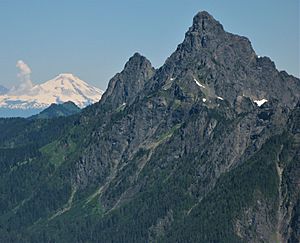White Chuck Mountain facts for kids
Quick facts for kids White Chuck Mountain |
|
|---|---|

West aspect, from Mountain Loop Highway
|
|
| Highest point | |
| Elevation | 6,989 ft (2,130 m) |
| Prominence | 3,789 ft (1,155 m) |
| Isolation | 4.93 mi (7.93 km) |
| Parent peak | Mount Pugh (7,201 ft) |
| Geography | |
| Location | Snohomish County, Washington, U.S. |
| Parent range | Cascade Range |
| Topo map | USGS White Chuck Mountain |
| Climbing | |
| First ascent | July 28, 1897 Albert Hale Sylvester, Thomas Gerdine, Sam Strom |
| Easiest route | class 5 climbing |
White Chuck Mountain is a tall peak in the North Cascades mountains of Washington state. Its native name is Hi Khaed. This mountain stands about 6,989 feet (2,130 meters) high. It is located in Snohomish County.
You can find White Chuck Mountain southeast of Darrington, Washington. It is also east of the Mountain Loop Highway. The mountain sits where the White Chuck River and the Sauk River meet. This area is part of the Mount Baker-Snoqualmie National Forest. The mountain gets its name from the White Chuck River. In Chinook Jargon, "chuck" means "water." The closest taller mountain is Mount Pugh, which is about 4.9 miles (7.9 km) away.
Weather at White Chuck Mountain
White Chuck Mountain is in a marine west coast climate zone. This means it has mild, wet weather. Most of the weather comes from the Pacific Ocean. It moves northeast towards the Cascade Mountains.
When weather fronts reach the North Cascades, the mountains force the air to rise. This causes the air to drop its moisture as rain or snowfall. This process is called Orographic lift. Because of this, the western side of the North Cascades gets a lot of rain and snow. Especially during winter, there is heavy snowfall. This wet, heavy snow can create a high risk of avalanches.
In winter, the weather is often cloudy. But in summer, high pressure systems over the Pacific Ocean bring clear skies. This means there is often little or no cloud cover. Temperatures rarely go below 0°F (-18°C) or above 80°F (27°C) in this area. The best time to visit or climb White Chuck Mountain is from July to September. This is when the weather is usually the nicest.
How White Chuck Mountain Formed
The North Cascades mountains have very rugged land. You can see jagged peaks, long ridges, and deep valleys carved by glaciers. The way the land looks today was shaped by huge geological events. These events happened millions of years ago. They caused big changes in elevation across the Cascade Range. These changes also led to different climates and types of plants in the area.
The Cascade Mountains started forming millions of years ago, during the late Eocene Epoch. The North American Plate was slowly moving over the Pacific Plate. This caused a lot of volcanic activity. For example, Glacier Peak is a stratovolcano about 15.5 miles (25 km) east-southeast of White Chuck Mountain. It began to form in the middle of the Pleistocene period. Also, small pieces of the Earth's crust, called terranes, helped create the North Cascades about 50 million years ago.
During the Pleistocene period, which was over two million years ago, glaciers moved across the land many times. As they moved, they scraped and shaped the landscape. They left behind piles of rock and debris. The "U"-shaped valleys of the rivers are a result of these glaciers. The land also rose up (called uplift) and cracked (called faulting). These processes, along with the glaciers, created the tall peaks and deep valleys you see in the North Cascades today.





